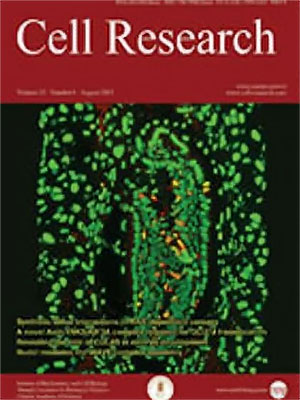
Volume 14, No 5, Oct 2004
ISSN: 1001-0602
EISSN: 1748-7838 2018
impact factor 17.848*
(Clarivate Analytics, 2019)
Volume 14 Issue 5, October 2004: 373-378
ORIGINAL ARTICLES
Defective maintenance of intracellular Ca2+ homeostasis is linked to increased muscle fatigability in the MG29 null mice
Marco A. P. Brotto1*, Ramakrishnan Y. Nagaraj1, Leticia S. Brotto1, Hiroshi Takeshima3,Jianjie Ma1, Thomas M. Nosek2
1Department of Physiology and Biophysics, UMDNJ-Robert Wood Johnson Medical School, Piscataway, NJ 08854, USA;
2Department of Physiology and Biophysics, School of Medicine, Case Western Reserve University, Cleveland, OH 44106, USA;
3Department of Biochemistry, Graduate School of Medicine,Tohoku University 2-1 Seiryo-machi, Aoba-ku, Sendai, Miyagi 980-8575, Japan
Correspondence: Marco A. P. Brotto(brottoma@umdnj.edu)
Mitsugumin 29 (MG29) is a transmembrane protein that is
normally found in the triad junction of skeletal muscle. Our previous
studies have shown that targeted deletion of
mg29 from the skeletal
muscle resulted in abnormality of the triad junction structure, and also
increased susceptibility to muscle fatigue. To elucidate the basis of
these effects, we investigated the properties of Ca
2+-uptake
and -release in toxin-skinned Extensor Digitorium Longus (EDL) muscle
fibers from control and
mg29 knockout mice. Compared with the control
muscle, submaximal Ca
2+-uptake into the sarcoplasmic reticulum
(SR) was slower and the storage of Ca
2+ inside the SR was less
in the mutant muscle, due to increased leakage process of Ca
2+ movement across the SR. The leakage pathway is associated with the increased
sensitivity of Ca
2+/caffeine -induced Ca
2+ release
to myoplasmic Ca
2+. Therefore, the increased fatigability of
mutant EDL muscles can result from a combination of a slowing of Ca
2+ uptake, modification of Ca
2+-induced Ca
2+ release
(CICR), and a reduction in total SR Ca
2+ content.
FULL TEXT | PDF
Browse 1875


